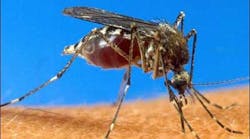Texas reports almost half of the cases in the USA. The CDC is not clear why the number of cases is greater this year than in recent years. Weather may be a contributing factor, with a mild winter followed by an early spring and a hot summer in many parts of the country possibly creating a more hospitable environment for mosquitoes, the primary mode of transmission. There is no vaccine against West Nile virus. The key to its control is killing mosquito larvae early in the year before they become adults and feast on birds, spreading the virus even faster. Mosquito-control programs, killing larvae in the spring, doing surveillance on adult mosquitoes and checking them for the virus, and organizing public awareness campaigns do work. There have, however, been concerns that massive spray efforts might trigger asthma or other health concerns. The best thing individuals can do is follow personal protection measures. Tests for West Nile virus may include blood work, computed tomography (CT) or magnetic resonance imaging (MRI) scans of the head, and lumbar puncture (spinal tap) for cerebrospinal fluid (the natural fluid that bathes the brain and spinal cord).(4) As always, prevention is the best policy.
Severe Symptoms of West Nile Virus • High fever, headache, neck stiffness, stupor, disorientation, tremors, convulsions, muscle weakness, vision loss, numbness, paralysis and coma. Other Symptoms • Body aches, nausea, vomiting and, sometimes, swollen lymph glands or a skin rash on the chest, stomach and back.
No Symptoms • Approximately 80% of people who are infected will not show any symptoms.
Precautions for Prevention • Use insect repellent and wear long sleeves and pants. • Fix screens on your windows and doors to keep mosquitoes out. • Empty standing water from flower pots, buckets and barrels. • Change the water in pet dishes and water in birdbaths frequently. • Drill holes in tire swings to drain water. • Empty wading pools when they aren't being used. The
Journal of the American Medical Association (JAMA) has prepared a
Patient Page on the West Nile Virus.(3) They source the National Institutes of Health, Centers for Disease Control and Prevention, and Cornell University Department of Entomology.
References 1. CDC.
http://www.cdc.gov/ncidod/dvbid/westnile/index.htm. 2. CDC Newsroom.
http://www.cdc.gov/media/releases/2012/t0822_west_nile_update.html. 3. Michigan Department of Community Health and U.S. Centers for Disease Control and Prevention. 4. Goodman DM and Livingston EH. JAMA.
http://jama.jamanetwork.com/.









